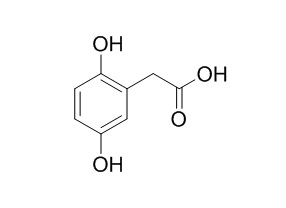Homogentisic acid
Homogentisic acid is the primary precursor of melanin synthesis in Vibrio cholerae, a Hyphomonas strain, and Shewanella colwelliana. Homogentisic acid shows interesting antioxidant and antiradical activities, and protective effect against thermal-cholesterol degradation. A derivative of homogentisic acid which inhibits Pfnek-1 with an IC(50) around 1.8 muM, this product is moderately active in vitro against a FcB1 P. falciparum strain (IC(50) = 12 muM).
Inquire / Order:
manager@chemfaces.com
Technical Inquiries:
service@chemfaces.com
Tel:
+86-27-84237783
Fax:
+86-27-84254680
Address:
1 Building, No. 83, CheCheng Rd., Wuhan Economic and Technological Development Zone, Wuhan, Hubei 430056, PRC
Providing storage is as stated on the product vial and the vial is kept tightly sealed, the product can be stored for up to
24 months(2-8C).
Wherever possible, you should prepare and use solutions on the same day. However, if you need to make up stock solutions in advance, we recommend that you store the solution as aliquots in tightly sealed vials at -20C. Generally, these will be useable for up to two weeks. Before use, and prior to opening the vial we recommend that you allow your product to equilibrate to room temperature for at least 1 hour.
Need more advice on solubility, usage and handling? Please email to: service@chemfaces.com
The packaging of the product may have turned upside down during transportation, resulting in the natural compounds adhering to the neck or cap of the vial. take the vial out of its packaging and gently shake to let the compounds fall to the bottom of the vial. for liquid products, centrifuge at 200-500 RPM to gather the liquid at the bottom of the vial. try to avoid loss or contamination during handling.
Sci Rep.2018, 8(1)
Academic J of Second Military Medical University2019, 40(1)
The Journal of Korean Medicine2022, 43(3): 79-93.
Front Immunol.2023, 14:1240800.
Biomed Pharmacother.2022, 146:112497.
Preprints2022, 2022030063.
Molecules.2020, 25(18),4089.
Pharmacol Rep.2020, 72(2):472-480.
Plant Cell, Tissue and Organ Culture (PCTOC)2020, 143, 45-60(2020)
J. ISSAAS2023, 29(2):36-51.
Related and Featured Products
Ann Clin Biochem. 2015 Sep;52(Pt 5):597-605.
Serum markers in alkaptonuria: simultaneous analysis of homogentisic acid, tyrosine and nitisinone by liquid chromatography tandem mass spectrometry.[Pubmed:
25628464]
Alkaptonuria is a rare debilitating autosomal recessive disorder of tyrosine metabolism, where deficiency of homogentisate 1,2-dioxygenase results in increased Homogentisic acid. Homogentisic acid is deposited as an ochronotic pigment in connective tissues, especially cartilage, leading to a severe early onset form of osteoarthritis, increased renal and prostatic stone formation and hardening of heart vessels. Treatment with the orphan drug, nitisinone, an inhibitor of 4-hydroxyphenylpyruvate dioxygenase has been shown to reduce urinary excretion of Homogentisic acid.
METHODS AND RESULTS:
A reverse phase liquid chromatography tandem mass spectrometry method has been developed to simultaneously analyse serum Homogentisic acid, tyrosine and nitisinone. Using matrix-matched calibration standards, two product ion transitions were identified for each compound (Homogentisic acid, tyrosine, nitisinone) and their respective isotopically labelled internal standards ((13)C6-Homogentisic acid, d2-tyrosine, (13)C6-nitisinone). Intrabatch accuracy was 94-108% for Homogentisic acid, 95-109% for tyrosine and 89-106% for nitisinone; interbatch accuracy (n = 20) was 88-108% for Homogentisic acid, 91-104% for tyrosine and 88-103% for nitisinone. Precision, both intra- and interbatch were <12% for Homogentisic acid and tyrosine, and <10% for nitisinone. Matrix effects observed with acidified serum were normalized by the internal standard (<10% coefficient of variation). Homogentisic acid, tyrosine and nitisinone proved stable after 24 h at room temp, three freeze-thaw cycles and 24 h at 4℃.
CONCLUSIONS:
The assay was linear to 500μmol/L Homogentisic acid, 2000μmol/L tyrosine and 10μmol/L nitisinone; increased range was not required for clinical samples and no carryover was observed.
Clin Biochem. 2014 May;47(7-8):640-7.
Interferences of homogentisic acid (HGA) on routine clinical chemistry assays in serum and urine and the implications for biochemical monitoring of patients with alkaptonuria.[Pubmed:
24373924]
We have assessed the effect of elevated concentrations of Homogentisic acid (HGA) as in alkaptonuria (AKU), on a range of routine chemistry tests in serum and urine.
METHODS AND RESULTS:
Homogentisic acid was added to pooled serum and a range of assays was analysed with Roche Modular chemistries. Effects on urine were assessed by diluting normal urine with urine from a patient with AKU, adding Homogentisic acid to urine and after lowering output of urinary Homogentisic acid with nitisinone treatment. Serum enzymatic creatinine showed 30% negative interference with 100μmol/L Homogentisic acid and >50% at 400μmol/L. Serum urate 100 to 480μmol/L was reduced up to 20% at 100 and to 50% with 400μmol/L Homogentisic acid. Serum cholesterol between 3 and 11mmol/L was reduced by 0.5mmol/L with 400μmol/L Homogentisic acid. Urine enzymatic creatinine and urate with >2mmol/L Homogentisic acid showed concentration dependent negative interference up to 80%. A positive interference in urine total protein by benzethonium turbidometric assay was observed, with 10mmol/L Homogentisic acid equivalent to 1g/L protein. Jaffe creatinine, Na, K, Cl, Mg, Ca, phosphate, ALT, GGT, ALP activities and urea in serum and or urine were not affected by increases in Homogentisic acid.
CONCLUSIONS:
To avoid interferences by Homogentisic acid in alkaptonuria concentration of Homogentisic acid should be established before samples are assayed with peroxidase assays and benzethonium urine protein.



